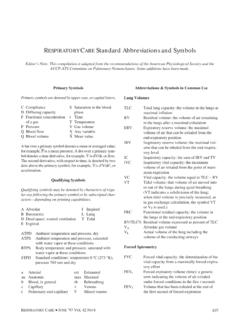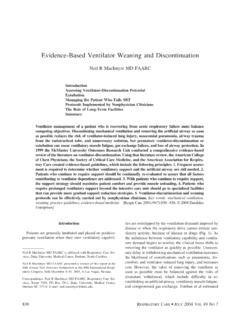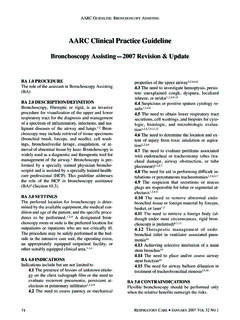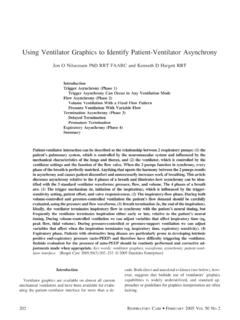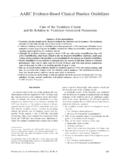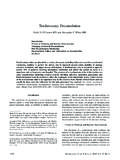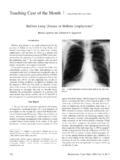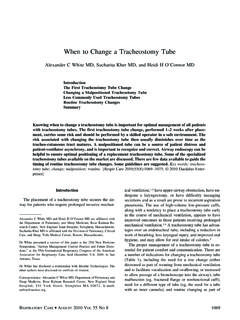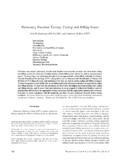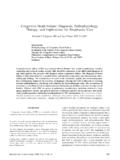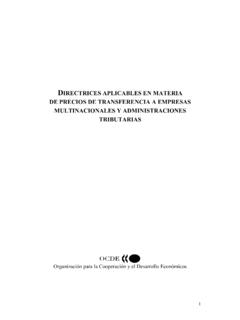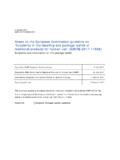Transcription of AARC Clinical Practice Guidelines - rcjournal.com
1 AARC Clinical Practice GuidelinesEndotracheal Suctioning of Mechanically Ventilated PatientsWith Artificial Airways 2010An electronic literature search for articles published between January 1990 and October 2009 wasconducted by using MEDLINE, CINAHL, and Cochrane Library databases. The update of thisclinical Practice guideline is the result of reviewing a total of 114 Clinical trials, 62 reviews and 6meta-analyses on endotracheal suctioning. The following recommendations are made following theGrading of Recommendations Assessment, Development, and Evaluation (GRADE) criteria: (1) Itis recommended that endotracheal suctioning should be performed only when secretions are present,and not routinely; (2) It is suggested that pre-oxygenation be considered if the patient has aclinically important reduction in oxygen saturation with suctioning; (3) Performing suctioningwithout disconnecting the patient from the ventilator is suggested.
2 (4) Use of shallow suction issuggested instead of deep suction, based on evidence from infant and pediatric studies; (5) It issuggested that routine use of normal saline instillation prior to endotracheal suction shouldnotbeperformed; (6) The use of closed suction is suggested for adults with high FIO2, or PEEP, or at riskfor lung derecruitment, and for neonates; (7) Endotracheal suctioning without disconnection (closedsystem) is suggested in neonates; (8) Avoidance of disconnection and use of lung recruitmentmaneuvers are suggested if suctioning-induced lung derecruitment occurs in patients withacutelung injury; (9) It is suggested that a suction catheter is used that occludes less than 50% the lumenof the endotracheal tube in children and adults, and less than 70% in infants; (10) It is suggestedthat the duration of the suctioning event be limited to less than 15 words: closed suction;endotracheal suction; saline instillation; intratracheal suction; open suction; saline lavage; suctioncatheter.
3 Tracheal suction; Clinical Practice guideline.[Respir Care 2010;55(6):758 764. 2010 Daeda-lus Enterprises]ETS DESCRIPTIONE ndotracheal suctioning (ETS) is one of the most com-mon procedures performed in patients with artificialairways. It is a component of bronchial hygiene therapyand mechanical ventilation that involves the mechanicalaspiration of pulmonary secretions from a patient s ar-tificial airway to prevent its procedureincludes patient preparation, the suctioning event, andfollow-up are 2 methods of endotracheal suctioning basedon the selection of catheter: open and closed.
4 Theopensuctioning technique requires disconnecting the patientfrom the ventilator, while theclosedsuctioning tech-nique involves attachment of a sterile, closed, in-linesuction catheter to the ventilator circuit, which allowspassage of a suction catheter through the artificial air-way without disconnecting the patient from the venti-lator. There are also 2 methods of suctioning based onthe catheter suction depth selected during the proce-dure: deep and suctioningis defined asthe insertion of a suction catheter until resistance is met,followed by withdrawal of the catheter by 1 cm beforeapplication of negative pressure, andshallow suction-ingas the insertion of a suction catheter to a predeter-mined depth, usually the length of the artificial airwayplus the PATIENT PREPARATIONIt is recommended to use smaller catheters whenever pos-sible, since suction pressure seems to have less influenceon lung volume loss than catheter a given di-ameter of the endotracheal tube (ETT)
5 , the level of nega-tive pressure transmitted to the airway is determined bythe combination of the catheter size and the suction pres-sure. The larger the diameter of the catheter size, the lessattenuation of the suction pressure through the of the suction catheter should not exceedone half the inner diameter of the artificial airway inadults, providing an internal-to-external diameter ra-758 RESPIRATORYCARE JUNE2010 VOL55 NO6tio of in adults,5,6and in infants andsmall preparation for the suctioning event, delivery of100% oxygen in pediatric8and adult patients9and10% increase of baseline in neonates10-12for 30 60 seconds prior to the suctioning event is suggested.
6 Especially in patients who are hypoxemic before ,14 This may be accomplished adjusting the FIO2setting on the mechan-ical ventilator, use of a temporary oxygen-enrichmentprogram available on many microprocessor ventilation of the patient is not rec-ommended, as it has been shown to be ineffectivefor providing delivered FIO2of ,17 Practitio-ners should ensure that PEEP is maintained if noother alternative is available to negative pressure of the unit must be checkedby occluding the end of the suction tubing beforeattaching it to the suction catheter, and prior to eachsuctioning event.
7 Suction pressure should be set aslow as possible and yet effectively clear data to support an appropriate maxi-mum suction level are lacking. Negative pressure of80 100 mm Hg in neonates18and less than 150 mm Hgin adults have been suctioning techniquefacilitates con-tinuous mechanical ventilation and oxygenation dur-ing the suctioning , may prevent lung derecruitment associ-ated with the use of open-suction system in pa-tients at higher risk of desaturation (eg, prematurenewborns). should be considered in patients requiringhigh FIO2and PEEP (eg, acute lung injury).
8 Neither increases nor decreases the risk ofventilator-associated changes of in-line suction cathetersdo not decrease the risk of ventilator-associatedpneumonia and is not , patient should be placed on a pulse oximeter toassess oxygenation during and following the PROCEDUREThe suctioning event consists of the placement of a suctioncatheter through the artificial airway into the trachea andthe application of negative pressure as the catheter is beingwithdrawn. Each pass of the suction catheter into the ar-tificial airway is considered a suctioning suctioning is recommended to preventtrauma to the tracheal suctioning has not shown superior benefitover shallow suction43and may be associated withmore adverse duration of each suctioning event should beno more than 15 ,47, technique is encouraged during open suc-tioning Normal saline instillation.
9 Instillation refers tothe administration of aliquots of saline directly intothe trachea via an artificial airway. It is hypothesizedthat normal saline instillation may loosen secretions,increase the amount of secretions removed, and aid inthe removal of tenacious secretions. However, there isinsufficient evidence to support this hypothesis. Nor-mal saline instillation appears to enhance secretionclearance through cough stimulation in adults,49and arecent report suggests that normal saline instillationprior to suctioning is associated with decreased inci-dence of ventilator-associated pneumonia in ventilatedadult great majority of the referencesused to update this guideline indicate that normal sa-line instillation is unlikely to be beneficial, and may infact be ,48,51-53 Therefore.
10 It should not beroutinely performed prior to performing FOLLOW-UP CAREF ollowing the suctioning for at least 1 min by followingthe same technique(s) used to pre-oxygenate the pa-tient may be used, especially in patients who are hy-poxemic before and/or during should not be routinely maneuvers may be at-tempted in patients with clear evidence of ,54, patientshould bemonitored for adverse SETTINGE ndotracheal suctioning may be performed by properlytrained persons in a wide variety of settings that include(but are not limited to) care s vehicleAARC CLINICALPRACTICEGUIDELINE.
